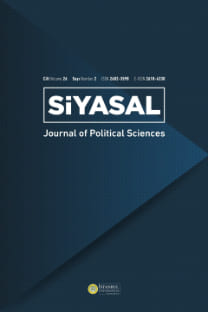Lessons from Best Practices: Japanese Administrative Reforms
Başarılı Uygulamalardan Örnekler: Japon Yönetsel Reformu
___
- Aucoin, P. (1990), "Administrative Reform in Public Management: Paradigms, Principles, Paradoxes and Pendulums," Governance, 3 (2), 115-137.
- Caiden G. (1991), Administrative Reform Comes of Age, Walter de Gruyter, Berlin.
- Caiden G. (1969), Administrative Reform, Aidine, Chicago.
- DiMaggio, P. and W. Powel (1985), "The Iron Cage Revisited: Institutional Isomorphism and Collective Rationality in Organizational Fields," American Sociological Review 48 April.
- Dolowitz, D. and D. Marsh (1996), "Who Learns What from Whom: a Review of the Policy Transfer Literature," Political Studies, June 1996 v44 n2.
- Eyestone, R. (1977), "Confusion, Diffusion, and innovation," American political Science review. 71, No. 2:441-47.
- Final Report of the Administrative reform Council, December 3, 1997. http://www.kantei. go.jp/foreign/
- Halligan, J. (1996), "The Diffusion of Civil Service Reform;' in Bekke, H, J. Perry, & T. Toonen Civil Service System: In Comparative System, Indiana University Press, Bloomington & Indianapolis.
- Hill, L. (1976), The Model Ombudsman, Princeton University Press, Princeton.
- Hood, C. (1995), "Contemporary Public Management: A New Global Paradigm," Public Policy and Administration, 10(2), 104-117.
- Hood, C. (1991), "A Public Management for all Seasons?" Public Administration Vol.69. Spring p.3-19.
- Ingraham, P. (1997), "Play it again, Sam; it's still not right: searching for the right notes in administrative reform," Public Administration Review, July- August v57n4 p325.
- Johnson, C. (1982), MITI and the Japanese Miracle: the Growth of Industrial Policy, 1925-1075, Stanford University Press, Stanford
- Jun, S. and H. Muto. 1995. "The Hidden Dimension of Japanese Administration Culture and its Impact". Public Administration Review. Volume 55 (2).p. 125- 134.
- Katz, E. et al. (1963), "Traditions of Research on Diffusion of Innovations," American Soc. Review, 28. P. 237-253.
- Kaul, M. & P. Collins (1996), "Governments in Transition: Towards a New Public Administration" Public Administration and Development. Vol.15, p. 199-206.
- Kaul, M. (1996), "Civil Service Reform: Learning from Commonwealth Experience," in Adamolekun, et all eds. Civil Service Reform in Francophole and Africa. The World Bank, Washington D. C.
- Kettl, D. F., and J. Dilulio (1995). Inside the Reinvention Machine: Appraising Governmental Reform. Washington, DC: Brookmgs.
- Kingston, W. (1977). Innovation: the Creative Impulse in Human Progress, John Calder, London.
- Laswell, H. (1948), "The Structure and Function of Communication in Society" in Lyman Bryson, ed. The Communication of Ideas. Harper, New York.
- Light, P. (1997), Tides of Reform: Making Government Work 1945-1995, Yale University Press, New Haven.
- Lowi, T. (1963), "Toward Functionalism in Political Science: the Case of Innovation in Party Systems" American political Science Review, 57(3), Sep. p. 570-83.
- Merirtt, R. and A. Merritt (1985), Innovation in the Public sector. Sage Publications, Beverly Hills.
- Miewald, R. and M. Steinman (1984), Problems in Administrative Reform, Nelson-Hall, Chicago.
- Muramatsu, M. and E. Krauss (1996), "Japan: The Paradox of Success," In Olsen and Peters Lessons from Experience: Experiential Learning in Administrative Reforms in Eight Democracies, Scandinavian University Press, Boston.
- Muramatsu, M. and F. Naschold (1997), State and Administration in Japan and GermanyWalter de Gruyter,. New York.
- Nunberg, B. (1997), "Leading the Horse to Water: Transnational Inducements to Administrative Reform," Paper presented at Conference on Comparative Civil Service Systems, University of Indiana Bloomington, Indiana April 8.
- OECD (1995), Governance in Transition: Public Management Reforms in OECD Countries.
- Olsert, J. and G. Peters. Eds. (1996), Lessons From Experience: Experiential Learning in Administrative Reforms in Eight Democracies, Scandinavian University Press, Boston.
- Osborne, D. & Geabler, T. (1992), Reinventing Government, Addison-Wesley, Reading, MA
- Pempel, T.J. (1992), Policy and Politics in Japan: Creative Conservatism. Temple University Press, Philadelphia.
- Peters, G. (1997), "Policy Transfers Between Governments: The Case of Administrative Reforms," West European Politics, Vol.20. No.4 (October), p.71-88.
- Peters, G. (1996), The Future of the Governing: Four Emerging Models, University Press of Kansas, Lawrence, Kansas.
- Regan, P. M. (1984), "British Administrative Reform: The need for Incentives," Public Administrative Review, 44. 545-550.
- Rockman, B. (1997), "Honey I Shrunk the State" in Ali Farazamand ed. Modern Systems of Government. Sage, Beverly Hills.
- Rogers, E. and F. Shoemaker (1971), Communication of Innovations: A Cross Cultural Approach, The Free Press, New York.
- Summary of the 1996 Annual Report of Management and Coordination Agency, http://www.somucho.go.ip/soumu/
- Tashiro, K. (1997), Comparative Study of Japanese Civil Sendee, Paper presented at Conference on Comparative Civil Service Systems, University of Indiana Bloomington, Indiana April 8.
- Wallace, L. (1997), Deepening Structural Reform: Lessons from Asia, International Monetary Fund, Washington D.C.
- Westney, E. (1987), Imitation and Innovation: The Transfer of Western Organizational Patterns to Meiji Japan, Harvard University Press, Cambridge. World Bank Development Report (1997), World Bank, Washington DC.
- Wright, D. and Sakurai, Y. (1987), "Administrative Reform in Japan: Politics, Policy, and Public Administration in a Deliberative Society". Public Administration Review, v47n2, 121-133, Mar/Apr.
- ISSN: 1303-1260
- Yayın Aralığı: 2
- Yayıncı: İstanbul Üniversitesi
İnternet Bankacılığında Müşteri Tercihleri Üzerine Bir Araştırma
Melis KARATAŞ, Hüseyin Sabri KURTULDU
"Batılılaşma" ve "Modernleşme" Üzerine Düşünceler: Tahtavi ve Dostoyevski
Finansal Krizler İçin Erken Uyarı Sistemleri
Lessons from Best Practices: Japanese Administrative Reforms
A Study on the Capital Structure of the Turkish Real Sector Firms
ABD'nin Hazar Enerji Politikası ve Türkiye
B. Bulut GÜRPINAR, Abdulkayyum KESİCİ
İdari ve Mali Paylaşım Açısından Merkezi Yönetim Yerel Yönetim İlişkileri
